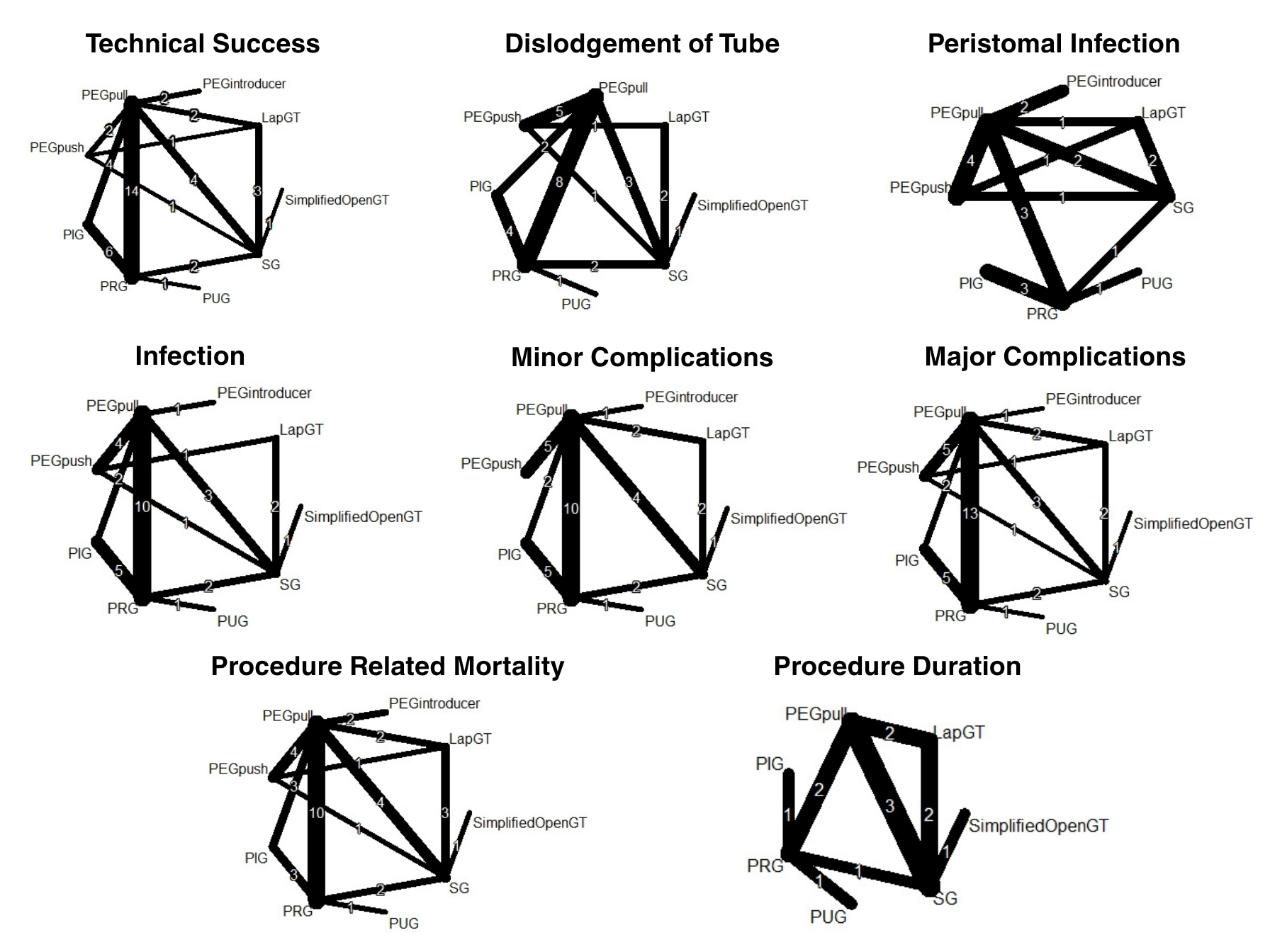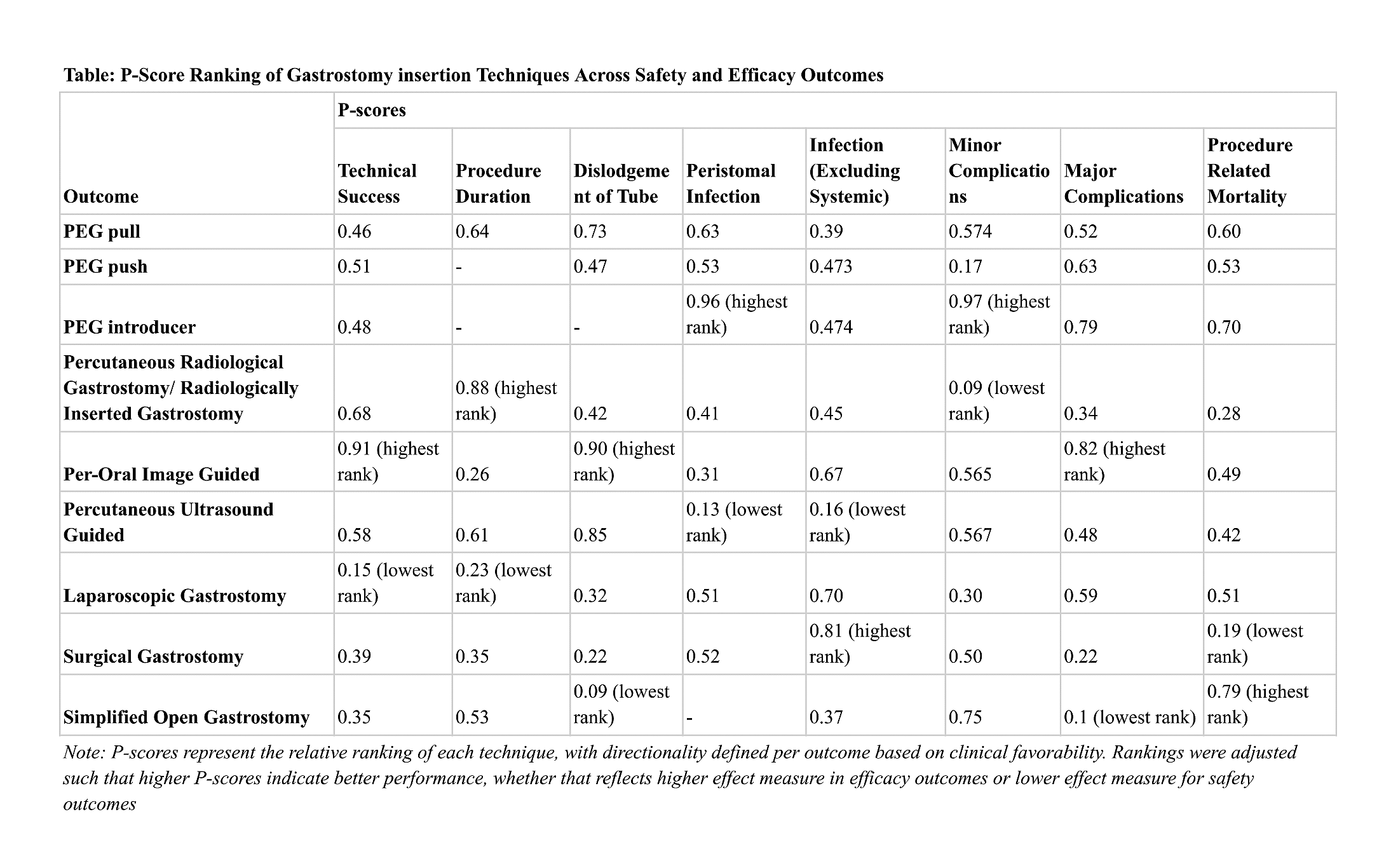Monday Poster Session
Category: General Endoscopy
P2995 - Comparative Efficacy and Safety of Gastrostomy Insertion Techniques: A Network Meta-Analysis
Monday, October 27, 2025
10:30 AM - 4:00 PM PDT
Location: Exhibit Hall

Uzair Majeed, MBBS (he/him/his)
South Oklahoma Heart
Oklahoma City, OK
Presenting Author(s)
Award: ACG Presidential Poster Award
Haneen Kamran, MBBS1, Uzair Majeed, MBBS2, Muhammad Umer, MBBS3, Umm e Aimen Minhas, MBBS1, Sameen Tahira, MBBS1, Mujtaba Rasool, MBBS1, Sarah Aijaz, MBBS4, Juaquito Jorge, MD5
1Allama Iqbal Medical College, Lahore, Punjab, Pakistan; 2South Oklahoma Heart, Oklahoma City, OK; 3Sahiwal Medical College, Sahiwal, Punjab, Pakistan; 4United Medical and Dental College, Karachi, Sindh, Pakistan; 5Private Practice/Independent Clinical Affiliate, USA, Chicago, IL
Introduction: Current guidelines, such as those from the 2025 American Society for Gastrointestinal Endoscopy, recommend percutaneous endoscopic gastrostomy (PEG) as the primary technique for enteral access. However, limited comparative evidence across insertion methods results in practice variability and inconsistent patient outcomes. Thus, this network meta-analysis was done to compare efficacy and safety of various gastrostomy insertion techniques.
Methods: A systematic search of PubMed, Embase, Cochrane, and Scopus was done for studies comparing at least two gastrostomy techniques in adults undergoing first-time placement. Evaluated techniques included Pull PEG, Push PEG, Introducer PEG, percutaneous radiologic gastrostomy (PRG), ultrasound-guided (PUG), laparoscopic (LapGT), surgical (SG), and per oral image-guided (PIG). Patients with GIT malignancies or < 18 years were excluded due to tumor related confounding and pediatric anatomical differences. Statistical analysis was conducted on R (v4.4.3), applying odds ratios (OR) for binary and standardized mean differences (SMD) for continuous outcomes. PEG Pull was set as the reference.
Results: From the 38 studies and 38,635 patients analyzed, PIG had the highest technical success (OR=4.14, CI:1.76–9.74, p=0.0012), followed by PRG (OR=1.66, CI:0.94–2.92, p=0.078). However, PRG significantly increased major (OR=1.14, CI:1.09–1.18, p< 0.0001) and minor complications (OR=2.42, CI:1.63–3.39, p< 0.0001). PEG Introducer significantly reduced minor complications (OR=0.09, CI:0.00–0.76, p=0.0018) and ranked best in reducing peristomal infections (OR=0.29, CI:0.08–0.77, p=0.081). Conversely, PIG showed highest OR for peristomal infections (OR=2.04, CI:1.25–5.52, p=0.22). SG presented the lowest risk for infections (OR=0.46, CI:0.14–2.29, p=0.14), but significantly increased tube dislodgement (OR=4.10, CI:1.42–11.80, p=0.0091) and procedure-related mortality (OR=2.02, CI:1.26-4.79, p=0.0091). PRG ranked highest for shortest procedure duration, (SMD=-1.34, CI:-3.60-0.92, p=0.24) while LapGT ranked lowest (SMD=1.78 (95% CI:-0.30-3.87, p=0.094). Netsplit analysis and net heat diagrams demonstrated minimal model inconsistency. Heterogeneity was low (I²< 35%), except for procedure duration.
Discussion: PIG demonstrated the highest technical success but with increased infection risk. PEG Introducer showed the best safety profile, while PRG is efficient but has more complications. These findings facilitate technique selection, and inform guideline refinement

Figure: Network diagrams depicting the direct comparisons between gastrostomy insertion techniques for each reported outcome.

Figure: P-Score Ranking of Various Gastrostomy Insertion Techniques Across Efficacy and Safety Outcomes
Disclosures:
Haneen Kamran indicated no relevant financial relationships.
Uzair Majeed indicated no relevant financial relationships.
Muhammad Umer indicated no relevant financial relationships.
Umm e Aimen Minhas indicated no relevant financial relationships.
Sameen Tahira indicated no relevant financial relationships.
Mujtaba Rasool indicated no relevant financial relationships.
Sarah Aijaz indicated no relevant financial relationships.
Juaquito Jorge indicated no relevant financial relationships.
Haneen Kamran, MBBS1, Uzair Majeed, MBBS2, Muhammad Umer, MBBS3, Umm e Aimen Minhas, MBBS1, Sameen Tahira, MBBS1, Mujtaba Rasool, MBBS1, Sarah Aijaz, MBBS4, Juaquito Jorge, MD5. P2995 - Comparative Efficacy and Safety of Gastrostomy Insertion Techniques: A Network Meta-Analysis, ACG 2025 Annual Scientific Meeting Abstracts. Phoenix, AZ: American College of Gastroenterology.
Haneen Kamran, MBBS1, Uzair Majeed, MBBS2, Muhammad Umer, MBBS3, Umm e Aimen Minhas, MBBS1, Sameen Tahira, MBBS1, Mujtaba Rasool, MBBS1, Sarah Aijaz, MBBS4, Juaquito Jorge, MD5
1Allama Iqbal Medical College, Lahore, Punjab, Pakistan; 2South Oklahoma Heart, Oklahoma City, OK; 3Sahiwal Medical College, Sahiwal, Punjab, Pakistan; 4United Medical and Dental College, Karachi, Sindh, Pakistan; 5Private Practice/Independent Clinical Affiliate, USA, Chicago, IL
Introduction: Current guidelines, such as those from the 2025 American Society for Gastrointestinal Endoscopy, recommend percutaneous endoscopic gastrostomy (PEG) as the primary technique for enteral access. However, limited comparative evidence across insertion methods results in practice variability and inconsistent patient outcomes. Thus, this network meta-analysis was done to compare efficacy and safety of various gastrostomy insertion techniques.
Methods: A systematic search of PubMed, Embase, Cochrane, and Scopus was done for studies comparing at least two gastrostomy techniques in adults undergoing first-time placement. Evaluated techniques included Pull PEG, Push PEG, Introducer PEG, percutaneous radiologic gastrostomy (PRG), ultrasound-guided (PUG), laparoscopic (LapGT), surgical (SG), and per oral image-guided (PIG). Patients with GIT malignancies or < 18 years were excluded due to tumor related confounding and pediatric anatomical differences. Statistical analysis was conducted on R (v4.4.3), applying odds ratios (OR) for binary and standardized mean differences (SMD) for continuous outcomes. PEG Pull was set as the reference.
Results: From the 38 studies and 38,635 patients analyzed, PIG had the highest technical success (OR=4.14, CI:1.76–9.74, p=0.0012), followed by PRG (OR=1.66, CI:0.94–2.92, p=0.078). However, PRG significantly increased major (OR=1.14, CI:1.09–1.18, p< 0.0001) and minor complications (OR=2.42, CI:1.63–3.39, p< 0.0001). PEG Introducer significantly reduced minor complications (OR=0.09, CI:0.00–0.76, p=0.0018) and ranked best in reducing peristomal infections (OR=0.29, CI:0.08–0.77, p=0.081). Conversely, PIG showed highest OR for peristomal infections (OR=2.04, CI:1.25–5.52, p=0.22). SG presented the lowest risk for infections (OR=0.46, CI:0.14–2.29, p=0.14), but significantly increased tube dislodgement (OR=4.10, CI:1.42–11.80, p=0.0091) and procedure-related mortality (OR=2.02, CI:1.26-4.79, p=0.0091). PRG ranked highest for shortest procedure duration, (SMD=-1.34, CI:-3.60-0.92, p=0.24) while LapGT ranked lowest (SMD=1.78 (95% CI:-0.30-3.87, p=0.094). Netsplit analysis and net heat diagrams demonstrated minimal model inconsistency. Heterogeneity was low (I²< 35%), except for procedure duration.
Discussion: PIG demonstrated the highest technical success but with increased infection risk. PEG Introducer showed the best safety profile, while PRG is efficient but has more complications. These findings facilitate technique selection, and inform guideline refinement

Figure: Network diagrams depicting the direct comparisons between gastrostomy insertion techniques for each reported outcome.

Figure: P-Score Ranking of Various Gastrostomy Insertion Techniques Across Efficacy and Safety Outcomes
Disclosures:
Haneen Kamran indicated no relevant financial relationships.
Uzair Majeed indicated no relevant financial relationships.
Muhammad Umer indicated no relevant financial relationships.
Umm e Aimen Minhas indicated no relevant financial relationships.
Sameen Tahira indicated no relevant financial relationships.
Mujtaba Rasool indicated no relevant financial relationships.
Sarah Aijaz indicated no relevant financial relationships.
Juaquito Jorge indicated no relevant financial relationships.
Haneen Kamran, MBBS1, Uzair Majeed, MBBS2, Muhammad Umer, MBBS3, Umm e Aimen Minhas, MBBS1, Sameen Tahira, MBBS1, Mujtaba Rasool, MBBS1, Sarah Aijaz, MBBS4, Juaquito Jorge, MD5. P2995 - Comparative Efficacy and Safety of Gastrostomy Insertion Techniques: A Network Meta-Analysis, ACG 2025 Annual Scientific Meeting Abstracts. Phoenix, AZ: American College of Gastroenterology.

